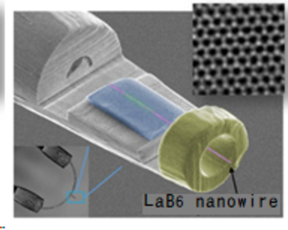Home > Press > Development of a high-energy-resolution, LaB6 nanowire-based field emission gun: Electron source enables atomic resolution TEM observation
 |
| SEM image of the LaB6 nanowire-based electron source. An atomic resolution image of single-layer graphene taken by a TEM equipped with this electron source is shown in the boxed image at upper right.
CREDIT Koji Kimoto National Institute for Materials Science Tel: +81-29-860-4402 Email: KIMOTO.Koji@nims.go.jp Zhang Han National Institute for Materials Science Email: Zhang.han@nims.go.jp |
Abstract:
The National Institute for Materials Science (NIMS) and JEOL, Ltd. have developed a lanthanum hexaboride (LaB6) nanowire-based field emission gun that is installable on an aberration-corrected transmission electron microscope (TEM). This combined unit is able to perform atomic resolution observation at an energy resolution of 0.2 eVthe highest resolution ever recorded for non-monochromatic electron gunswith a high current stability of 0.4%.
Development of a high-energy-resolution, LaB6 nanowire-based field emission gun: Electron source enables atomic resolution TEM observation
Sengen, Japan | Posted on December 10th, 2021
Unsuccessful efforts have been made for more than 20 years to develop field emission guns using theoretically high-performance nano materials. It has been found challenging to integrate a nanowire-based field emission gun into an electron microscope without undermining its physical properties, such as lives and stability. For this reason, commercially available field emission guns are still equipped with tungsten needles developed more than half a century ago.
This NIMS-JEOL research team 1) developed techniques to chemically synthesize and grow high-purity, single-crystal nanowires of LaB6, known to be an excellent electron-emitting hot cathode material, 2) designed an electron source mechanism capable of efficiently emitting electrons and 3) developed techniques to extract a single nanowire and integrate it into an optimized electron source structure.
The LaB6 nanowire-based electron source has a number of advantages: relatively moderate vacuum condition requirements, very high current stability, low extraction voltage, narrow electron beam energy distribution width and high brightness. This electron source may be applicable to the development of next-generation field emission electron microscopes with higher spatial and energy resolutionpotentially valuable tools in the semiconductor and medical fields.
***
This project was carried out by a team of NIMS researchers (Han Zhang, Cretu Ovidiu, Koji Kimoto, Takeshi Kasaya, Hideki T. Miyazaki, Naohito Tsujii, Hongxin Wang, Yasushi Yamauchi and Daisuke Fujita) and JEOL researchers (Yu Jimbo, Akira Niwata, Akihiro Ikeda, Akira Yasuhara, Shin-ichi Kitamura and Hironobu Manabe).
This research was published in the online version of Nature Nanotechnology on November 9, 2021, Japan Time (DOI: 10.1038/s41565-021-00999-w).
####
For more information, please click here
Contacts:
Yasufumi Nakamichi
National Institute for Materials Science, Japan
Office: 81-29-859-2105
Expert Contacts
Zhang Han
National Institute for Materials Science
Koji Kimoto
National Institute for Materials Science
Copyright © National Institute for Materials Science, Japan
If you have a comment, please Contact us.
Issuers of news releases, not 7th Wave, Inc. or Nanotechnology Now, are solely responsible for the accuracy of the content.
News and information
![]()
Resolving the puzzles of graphene superconductivity: Physicists publish a theoretical framework to explain the recent discovery of superconductivity in trilayer graphene December 10th, 2021
![]()
DeepMind simulates matter on the nanoscale with AI December 10th, 2021
Imaging
![]()
New microscopy method offers 3D tracking of 100 single molecules at once November 19th, 2021
![]()
Visualizing temperature transport: An unexpected technique for nanoscale characterization November 19th, 2021
![]()
Tweezer grant pleases Rice researchers: University wins NSF grant to acquire optical tweezer to manipulate micron-scale matter September 10th, 2021
Possible Futures
![]()
Resolving the puzzles of graphene superconductivity: Physicists publish a theoretical framework to explain the recent discovery of superconductivity in trilayer graphene December 10th, 2021
![]()
DeepMind simulates matter on the nanoscale with AI December 10th, 2021
![]()
PASQAL announces quantum computing collaboration with NVIDIA December 10th, 2021
Discoveries
![]()
Resolving the puzzles of graphene superconductivity: Physicists publish a theoretical framework to explain the recent discovery of superconductivity in trilayer graphene December 10th, 2021
![]()
DeepMind simulates matter on the nanoscale with AI December 10th, 2021
![]()
PASQAL announces quantum computing collaboration with NVIDIA December 10th, 2021
Announcements
![]()
DeepMind simulates matter on the nanoscale with AI December 10th, 2021
![]()
PASQAL announces quantum computing collaboration with NVIDIA December 10th, 2021
![]()
Innovative silicon nanochip can reprogram biological tissue in living body December 10th, 2021
![]()
A new mechanism for generation of vesicles that transport molecules and vaccine nanoparticles into living cells December 10th, 2021
Tools
![]()
New microscopy method offers 3D tracking of 100 single molecules at once November 19th, 2021
![]()
Inspired by photosynthesis, scientists double reaction quantum efficiency October 1st, 2021
![]()
Ultrasound at the nanometre scale reveals the nature of force September 17th, 2021
![]()
Tweezer grant pleases Rice researchers: University wins NSF grant to acquire optical tweezer to manipulate micron-scale matter September 10th, 2021










